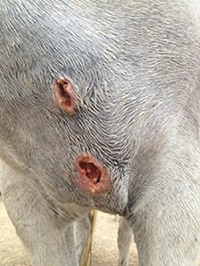Pigeon Fever

affected in "pigeon fever"
(NY) A 6-year-old warmblood gelding was diagnosed with "pigeon fever," which is reportable in New York state. The gelding had a history of being from the western part of the United States and had a traumatic incident two weeks before the diagnosis of this disease. Corynebacterium pseudotuberculosis is the causative agent in pigeon fever, and the name is derived from the swelling that often occurs in the pectoral muscles, which resembles a pigeon's breast.
Over the last few years, more states have reported cases of pigeon fever which had not reported in their state previously. Corynebacterium pseudotuberculosis "biovar ovis" causes caseous lymphadenitis in small ruminants; and the equine diseases, which include pigeon fever and ulcerative lymphangitis, are caused by the "biovar equi." The natural cross-species transmission does not occur between horses and small ruminants but can occur in cattle and horses. Cattle have both biotypes. This disease is endemic in the Southwestern part of the US, Australia, and Brazil. There is a seasonal incidence associated with the presence of biting flies, but in this reported case biting flies were not active in NY at the time of infection. It is not contagious between horses, but the abscesses serve as a source of environmental contamination. There is a zoonotic concern for pneumonia and lymphadenitis.
Corynebacterium pseudotuberculosis causes suppurative abscesses, both internally and externally, and ulcerative lymphangitis. It may affect any age of the horse, but young horses appear to be more susceptible. Internal abscesses can cause systemic illness and be challenging to diagnose. The abscess material should be cultured aerobically for a definitive diagnosis. Internal abscesses can be diagnosed with the help of a serological SHI test (synergistic hemolysis inhibition) in horses with compatible signs.
Biosecurity procedures should be in place to prevent the contamination of the soil if abscesses are actively draining and attention to fly control. Veterinarians should have this disease on their list of differentials in horses with chronic colic, lymphangitis, external and internal abscesses, poor doer, and other undiagnosed conditions.


